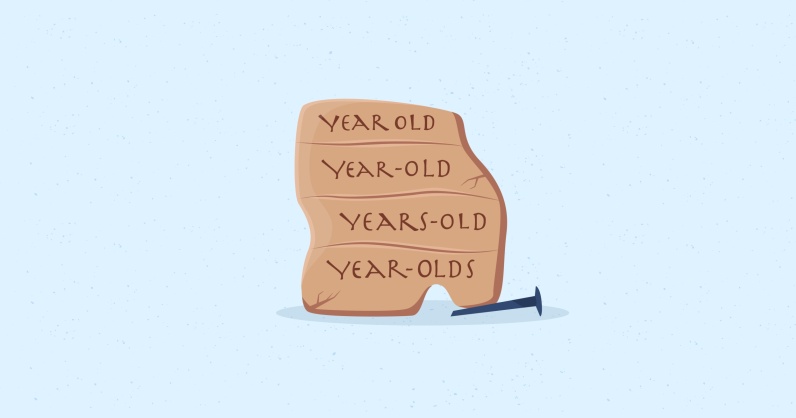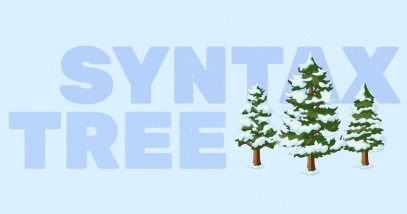The Age-Old Problem of Age

Getting clear on how to describe age in English can give anyone a few grey hairs. Is it eight-year-old or eight year old? Years old or just years? When can we drop years old entirely? And what’s going on with years of age?
Whether (delicately) asking someone how old they are or describing the same about yourself, references to age frequent our communication. Reciting one’s age is among the first things that students of a foreign language learn. Regulations for admissibility to programs or services often set an age limit. We casually bring up how old our relatives or pets are without a second thought. Age, it seems, never gets old.
Acknowledging that confusion around this subject is itself long in the tooth, this article breaks down the nuances of words and phrases that reference age. Because none of us are getting any younger, we’ve limited discussion to the most common constructions. To learn more about expressions and verbs that signal a transition between ages, see our Language Matters article Become and Other Words of Change.
A quick note: conventions for writing numbers that reference age differ among sources. The Chicago Manual of Style spells out ages below 100 (a seventy-seven-year-old law). The Associated Press favours numbers for all ages (a 77-year-old law). This article adopts the Chicago conventions.
Year-Old or Year Old?
When it comes before the noun that it modifies, the phrase year-old takes a hyphen. Any number added to the front of the phrase must join with a hyphen because all discrete words that comprise a compound modifier form one word.
I have a five-year-old chihuahua.
It’s possible for year-old to stand without a number if it modifies a noun that is one year old.
She’s working on a year-old case.
Also correct: She’s working on a one-year-old case.
The phrase year old (without the hyphen) falls after the noun and modifies the number one.
My dog is one year old.
If the age of the subject is over one, then year becomes years.
My dog is two years old.
Year-Old or Year-Olds?
Confusion flares up when we see sentences like He has a two-year-old. When the phrase X-year-old (where X is a number) functions as a noun, it must be hyphenated. Its plural form takes an s on the end of old.
They dropped off their five-year-old at camp.
The couple has two seven-year-olds.
X-year-old as a noun almost always refers to humans and often implies the word child or kid (or their plural forms), which can be omitted in this construction. I have a two-year-old means that the speaker has a two-year-old child, not a two-year-old dog, cat, parakeet or goldfish—those nouns would need to be specified after the adjective X-year-old (except when context clarifies the implied noun, as when pet owners talk about their pets).
I have a two-year-old.
This is a nominalized adjective; child is the implied noun.
I have a two-year-old cat.
This is a compound adjective modifying cat.
Do you have a poodle too? — Yes, a four-year-old.
The context of the exchange means the respondent does not need to repeat poodle.
Using X-year-old to describe someone past their adolescence is less common but no less correct. Usually we do this to highlight an adult’s age relative to an age-related benchmark or expectation.
She’s accumulated more wealth than most twenty-two-year-olds.
Pointing out the person’s exact age reinforces how she stands apart from others near her age.
My friend told me that he’s dating a forty-five-year-old.
Specifying the adult’s age likely means that the speaker’s friend is considerably younger or older.
It is possible to speak of a group of adults of the same age, such as in a room of fifty-year-olds, though this would be a rare gathering indeed of adults all aged fifty. A sentence like The event is open to forty-year-olds and over is, again, possible, but not common: you are much more likely to see people forty and over or a similar construction.
A good general rule: children and teens are described in a more granular fashion than adults in terms of age because of their distinct developmental and legal milestones. After a person’s adolescence, we tend to reference their age in broader units, like decades. We cover this point in more detail later.
Year-Old or Years-Old?
Many non-native speakers assume (understandably) that a noun joined to a plural number must take a plural form. How can year remain singular when it follows five in five-year-old chihuahua? It’s possible because X-year-old (when correctly hyphenated and placed before the noun it modifies) functions as a singular adjective—even when a plural number sits in the string. This is no different from other attributive compound adjectives that include a plural number.
This is a sixty-year-old house.
I drive a four-door car.
He’s biking on a two-lane highway.
A seeming inconsistency crops up here: if year remains singular when joined to a plural number in two-year-old cat, how do we explain the plural in constructions like the following?
The ruling capped a years-long legal fight.
The nuance goes like this: if the first word of the attributive adjective string is a time unit (not a number, but the unit itself), it can take a plural form. You may notice the modifier long is common in these constructions; it expresses the duration of something.
The group carried out a months-long protest.
He just completed decades-long research.
Omitting Years Old
Imagine you’re bragging about your grandmother. “She’s 100!” you announce. Now imagine you’re bragging about your grandmother’s prized antique thimble. You would catch confused looks if you said, “This is 100!” Why?
English speakers can omit the words years old in the construction [be + number] when describing the age of living things—but not objects. For centuries, writers habitually added phrases like years of age or, less formally, years old to clarify that a number in reference to a person signalled their age. But around the seventeenth century, writers started to use [be + number] as well. An early example of this comes from the 1619 British drama The Maid’s Tragedy. Referring to a boy, the character Amintor prophesies,
When he is twelve,
He shall command against the foes of Rhodes.1
Because a person’s age is central to our understanding of and expectations for their behaviour or status, this characteristic has acquired a special stature in which the qualifying words (years old) have become optional. Clues indicate that this omission was gradual. Some texts published in the 1700s contain sentences that do away with years of age or years old when one of those phrases was previously used nearby, suggesting that authors trusted readers to infer that referring to someone “at” or “being” a number indicated their age in years. Excerpts from a 1793 English translation of Jean-Jacques Rousseau’s Emile bear this out:
He hardly knows, at fifteen years of age, whether or not he hath a soul; and perhaps it will not be time to inform him of it when he is eighteen.
When you see their avarice excited by rewards, and hear them applauded, at ten years old, for their performance in some public exercise in the academy, you just see how they will leave their purse in a gaming-house at twenty, and their health in a brothel.2
Omitting years old is possible largely due to inferred semantics that emerge from context. Speakers often cut the adjective from a modifying phrase when no confusion results. The movie is 90 minutes long can easily shorten to The movie is 90 minutes because we know that minutes refers to the temporal length of the movie, thus rendering long unnecessary (though not incorrect). The wall is six feet could be understood as six feet tall or six feet wide, so it’s best to clarify the adjective. My bag is 20 pounds overweight is not at all the same thing as My bag is 20 pounds. The adjective in these constructions is sometimes superfluous, sometimes necessary for comprehension.
As for age, the construction She is thirty years doesn’t work even though the unit years implies the passage of time contained in old. This is a nasty trap for non-native speakers, who may feel caught between She is thirty (correct), She is thirty years old (correct) and She is thirty years (incorrect!).
The omission of years old is all well and good for living things. But if a speaker leaves those words out when describing the age of an object, listeners may not understand. Remember your grandma’s thimble? In a certain light, This thimble is 100! might come across as an offer to sell it for $100. Sentences like this skirt around grammatical violation, but semantically they will likely cause confusion—and could land you in hot water with your grandma if the sale goes through.
Adding And a Half
Before 1900, roughly, speakers who added and a half to an age tended to place it directly after the time unit.
“May I go to ride with you to-day, mamma?” said Mary R. a little girl of
three years and a half old.3
This formation sounds archaic today. As the twentieth century ticked over, the norm became to set and a half between the number and the time unit.
He is two and a half years old.
As we have seen, though, when age is contextually implied in reference to living things, speakers often drop all mentions of year(s) and old, leaving us with He is two and a half.
If placed as a modifier before a noun, and a half slots in between the number and the time unit. Like other compound attributive adjectives, the entire phrase is hyphenated.
I have a two-and-a-half-year-old daughter.
If used as a noun (again, usually in reference to an implied child), the hyphens connect all discrete words in the compound.
I have a two-and-a-half-year-old.
I have two three-and-a-half-year-olds.
Years of Age and Aged
The phrase years of age has been around for centuries and, like years old, is optional.
My niece is seven years of age.
Since the turn of the twentieth century, however, written instances of years of age have declined. Today it rings more old-fashioned than years old, and you are more likely to encounter it in formal contexts than casual conversation.
A pithy alternative in written form to years of age is aged. A past participle of the verb to age, it comes before the number and does away with the need for years and old. It also helps avoid longer constructions that require a prepositional phrase or relative clause.
He died aged eighty.
Alternative to He died at the age of eighty.
I have one child: Malcolm, aged eight.
Alternative to Malcolm, who is eight.
Years Young
The phrase years young is a light-hearted twist on years old. People might say this to soften the fact of aging or to stress how youthful someone appears or feels. As such, years young conventionally describes older people.
Please help me wish Walter a happy birthday. He’s ninety years young today!
I’m seventy-five years young, and I’ve never felt better!
Ironically, the younger a person is, the weirder the phrase seems in association with them.
He's maybe twenty years young.
This sounds bizarre; we do not usually say years young when describing a relatively young person.
Some Things About -somethings
As mentioned, after someone’s teen years, it becomes more natural to refer to their age according to ten-year intervals (twenty, thirty, etc.). In this case, the word X-something is useful.
He’s a thirty-something guy.
This means the person’s age falls between thirty and thirty-nine inclusively. Speakers might say this because they are guessing at a general age, because an exact age is immaterial, or to mask a precise age.
X-something can be an attributive adjective (placed before a noun that it modifies) or a noun, but its spelling is not straightforward. As an attributive adjective, it retains the hyphen, and the number can be written as a numeral or a word. As we saw with year-old, it remains singular in this role.
I’m a 50-something professional.
She’s a fifty-something librarian.
If X-something is a noun, the number can again be written as a numeral or a word—but the hyphen becomes optional only in the latter case.
The thought of a twentysomething running for mayor is amazing.
You can also write twenty-something or 20-something, but not 20something.
As a plural noun, this word takes the customary -s inflection.
This event is for 20-somethings who want to mingle with peers.
This use of -something to signal approximation is not exclusive to expressions of age. It appears in many contexts (He ate 20-something hotdogs) and is often shortened to -some (Give me 20-some feet of rope). Only as a noun in reference to age can the spelling omit the hyphen and collapse the two words into one (e.g. fiftysomething), signalling the settled nature of these nouns as words in the lexicon.
Aging Gracefully
As we have seen, for a subject as universal as age, describing how old people and things are proves complicated. Here we offered a primer on common references to age in English and the confusions they can produce. Hopefully this article has armed you with enough insight to last you, if not a lifetime, at least many years to come.
-
Francis Beaumont and John Fletcher, “The Maid’s Tragedy,” in The British Drama: Comprehending the Best Plays in the English Language, vol. 3 (London, 1804), 10, Google Books. ↩
-
Jean-Jacques Rousseau, Emile, Or, a Treatise of Education, translated from the French, vol. 2 [translator unknown] (Edinburgh, 1773), 101, Google Books. ↩
-
A Mother, Little Mary: A Story for Children From Four to Five Years Old (Boston, 1831), 3, Google Books. ↩




